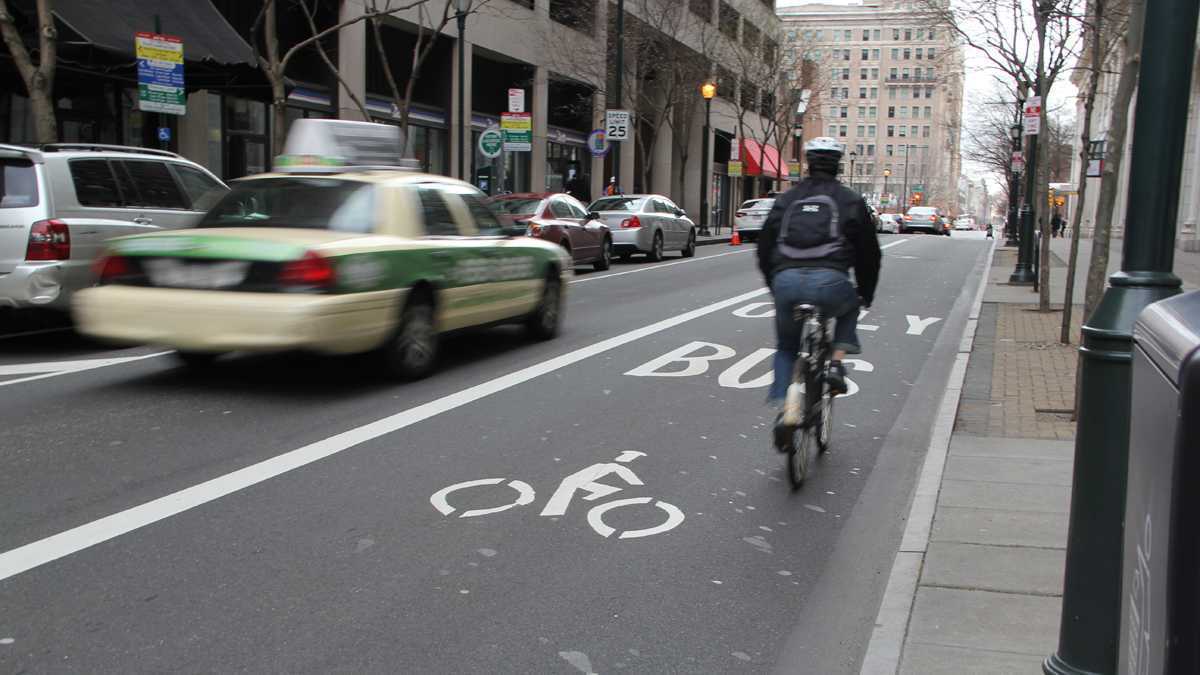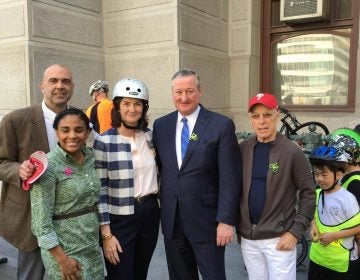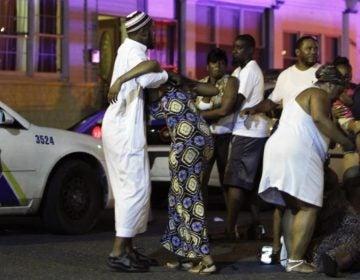The National Motorists Association’s drive toward alternative facts

(Emma Lee/WHYY
There’s been a dangerous move in the United States recently toward fake news and reclaiming a version of America that never existed. And nowhere was that more blatantly on display than in James Sikorski’s recent NewsWorks op-ed, where he attacks Vision Zero — a policy that strives to bring traffic deaths down to zero — as a “total disaster.”
Sikorski, a representative of the National Motorists Association from Luzerne County, argues that creating new engineering, education, and enforcement strategies for road users in Philadelphia will actually make the city a more dangerous place to move around.
This is objectively false. I don’t like having to feed the trolls when they pop up on my feed, but it’s important that people like Sikorski know their blatant disregard for the truth makes our streets more dangerous.
First, let’s understand what the National Motorists Association is: an extremist fringe group that thrives on emotional explanations to reason that humans should be able to drive cars without consequences.
Their representatives have actually argued that hit-and-run drivers should not be penalized for leaving the scene of a crash in which pedestrians are murdered.
They use outdated, out-of-context statistics to fight traffic-calming tools that have been shown to make streets safer for all road users.
Sikorski seems to think roads should be a safe space for drivers. I agree. But cyclists, pedestrians, people in wheelchairs, and, well, everyone, should also be safe. Here are some of the many factual errors in Sikorski’s recent Newsworks op/ed.
’85th percentile’
Sikorski begins his argument by saying “maximum safety on roads occurs” when speed limits are set to the “85th percentile free-flowing traffic speed.” This is the closest thing to a sound argument.
But it’s still wrong.
The NMA often uses the 85th percentile argument in their media. It’s the idea that speed limits should be based on the average speed that 85 percent of drivers are wont to move on a given street.
The only problem? This figure, based on the 1964 “Solomon Curve,” was meant for freeway-type traffic, and was never intended for city streets that cater to motorists, pedestrians, and bicyclists.
Does that mean safety on the Pennsylvania Turnpike? Maybe, although the idea is widely seen as archaic.
Does it mean safety on, say, Chestnut Street in Philadelphia, where through drivers share their space with cyclists, frequently stopping buses, people trying to park their cars, and pedestrians? Absolutely not.
Automated cameras
Due to the potential for conspiracy and surveillance, red light and speed camera legislation has been scrutinized and virtually perfected since it became a mainstream option for traffic safety in the mid-aughts.
To claim automated enforcement doesn’t work, Sikorski’s op-ed references a 12-year-old Philadelphia Weekly article in which it is claimed crashes on Roosevelt Boulevard went up immediately after installing three cameras.
More recent data tells a different story.
According to a 2011 report by the Pennsylvania State Transportation Advisory Committee, the state’s Automated Red Light Enforcement (ARLE) program “has improved safety” related to red-light running. The same is true all over the country.
“A review of the operational intersections indicates that the program has successfully reduced red-light running violations by an average of 48 percent within the first 12 months of enforcement,” reads the report, signed off by a bipartisan group of Pennsylvania legislators, commissioners, administrators, and others. “The total number of crashes has also declined by 24 percent for the 10 ARLE intersections where three years of crash data after ARLE’s commencement is available. Fatalities and the overall severity of crashes have also declined. These results are consistent with national statistics on automated red light enforcement.”
The Insurance Institute for Highway Safety, which studies red-light cameras, found the same to be true in the other cities and counties.
In Montgomery County, Maryland, for instance, IIHS “found that the camera program resulted in a 19 percent reduction in the likelihood that a crash would involve a fatality or an incapacitating injury, as reported by a police officer on the scene.”
Automated enforcement works. That’s why Pennsylvania’s red-light camera legislation was extended for an additional 10 years in 2016. The Bicycle Coalition of Greater Philadelphia is proud to have worked assiduously to support that renewal by the state legislature.
Vision Zero in New York City
Perhaps most glaring and easy to fact-check is Sikorski’s claim that the results of New York City’s Vision Zero police “have not been very good” — using a Patch.com link to make his point.
Looking at the actual data from NYC.gov, rather than a hyper-local opinion piece, shows the opposite is true.
New York City introduced Vision Zero in 2013 and has experienced a 23 percent decline in traffic deaths since then.
“2016 was the safest year on record in New York City,” New York City Police Commissioner James O’Neill noted in a January 2017 press release.
New York City’s decline is significant in that it “runs counter to national trends”: Traffic deaths have actually been going up nationally as the economy has gotten stronger and smart phones increasingly distract people behind the wheel. Not the case in New York.
Responsibility
The op-ed posits that pedestrians and bicyclists are the real culprits in road deaths. While no evidence is used to back up this emotional point (other than a link to a blog post by Stu Bykofsky), it’s worth noting that Sikorski copy-and-pasted the exact same language (“How many of these crashes … are the fault of these people, not the cars? … It’s time for pedestrians and bicyclists to be fully aware of all laws, pay attention …”), from a March 25, 2016, op-ed for Philly.com he wrote.
Blaming all victims who are not motorists for their own demise is heartless at best and cruel at worst. People may make mistakes, but no one deserves to die because they stepped into or rode a bike on a street. Especially when it is so totally unnecessary.
The facts are this: Most fatal and severe crashes are caused by motorists driving at excessive speed. According to the Pennsylvania State Mayors Association, Pennsylvania has most speed-related traffic deaths in the United States, after Texas and California. That’s a problem.
It’s hard to say if members of the National Motorists Association really want to have a conversation about this issue. But if they do, they should come to the Vision Zero 2017 Conference on March 1 at Thomas Jefferson University.
Contrary to the belief that Vision Zero is meant to “keep cars out of the city,” as the op-ed notes, the March 1 conference is presented by Uber and sponsored by AAA.
The Bicycle Coalition is glad to have them, and others, at the table to discussing how to make Philadelphia safer for everyone. It’s not about cars vs. bikes, or cars vs. people, it’s about working together to make our city safer and better for everyone.
—
Randy LoBasso is the communications manager for the Bicycle Coalition of Greater Philadelphia.
WHYY is your source for fact-based, in-depth journalism and information. As a nonprofit organization, we rely on financial support from readers like you. Please give today.




